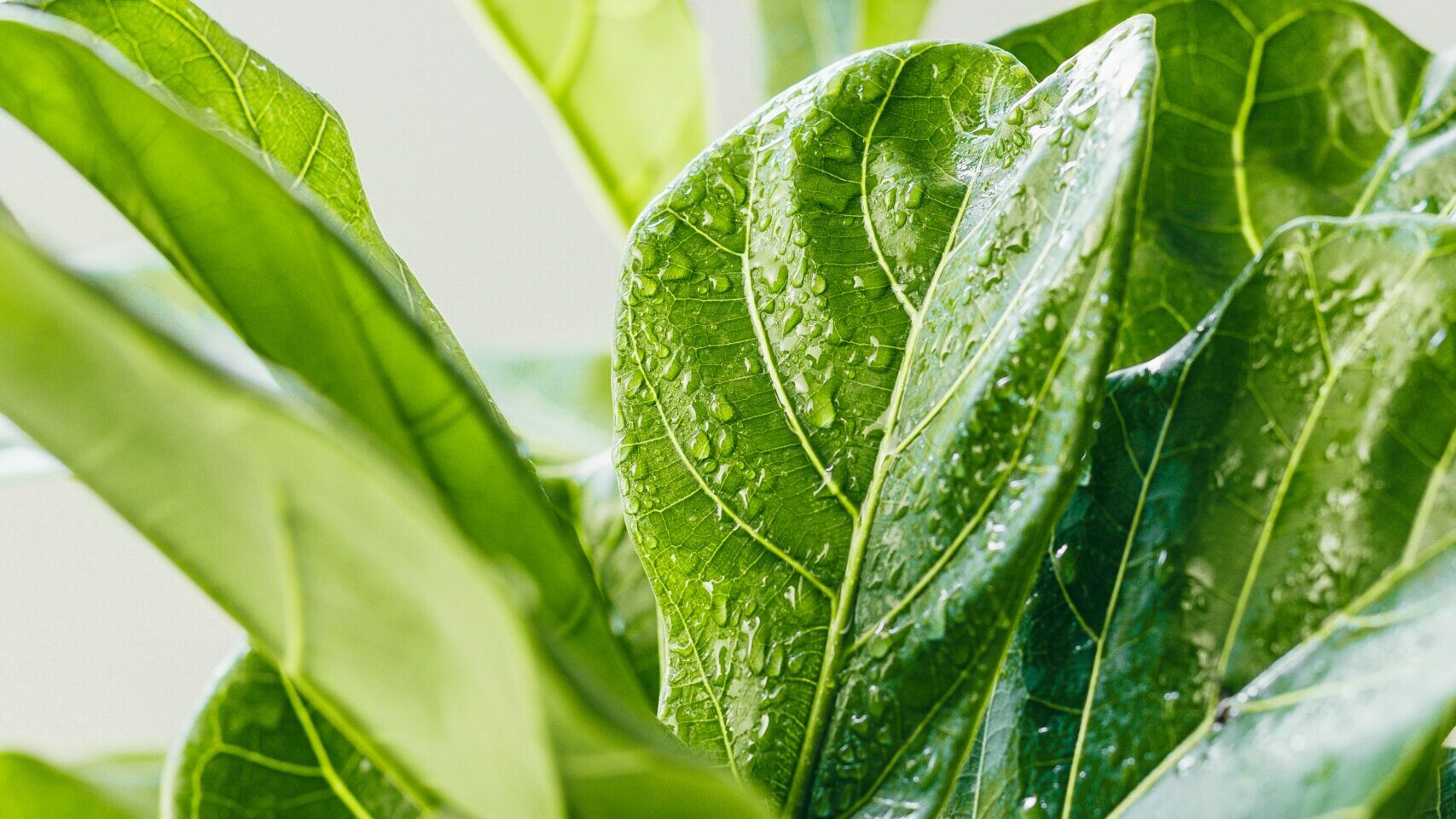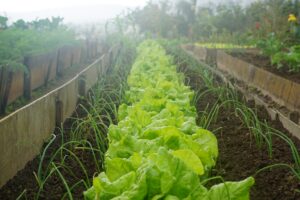How to Grow and Care for Your Indoor Fiddle Leaf Fig

The Fiddle Leaf Fig – or Ficus Lyrata – is a popular indoor plant with large vibrant green leaves, hailing from the steamy rainforests of Africa.
Fiddle Leaf Figs are fairly large plants in general; they grow up to 15-30 metres in the wild and can easily reach between 6 and 10 feet high indoors. If this sounds a bit daunting to you, don’t worry. Smaller ‘Ficus Lyrata Bambino’ varieties are also available.
These splendid plants will look striking in a home or commercial space. But they definitely need a bit of careful love to really thrive. Fiddle Leaf Figs may have developed a reputation for being fussy, yet they’re actually quite resilient if you can get the conditions right.
Here’s how to grow and care for your Fiddle Leaf Fig indoors.
Potting your Fiddle Leaf Fig
You should pick a larger-than-average pot for Fiddle Leaf Figs, because this plant grows quickly. Don’t choose a pot that’s too much larger than your plant though, or the soil may take on more water than the plant needs, potentially leading to root rot.
Root rot and leaf-dropping are very common issues with these plants. Try to select a pot with good drainage to prevent the roots from becoming soggy and waterlogged. A good rule of thumb when potting is to look for a pot that is slightly larger than the ball of the root.
To keep your Fiddle Leaf healthy and happy, you should re-pot it every couple of years or so into a slightly larger pot. You will likely need to repot this plant every Spring while it is young, as the growth can be quite rapid. But be careful if you decide to repot it in winter, because exposure to cold temperatures (10-15 degrees Celsius or lower) may stress out or kill this plant.
Repotting will become fairly difficult once your Fiddle Leaf Fig matures into a large plant. When repotting is no longer possible, it may still help to replace the top layer of soil (down to about 5-10cm or so) every Spring.
Watering
The key to watering your Fiddle Leaf Fig is moderation. Overwatering is probably the most common cause of death for these plants, so don’t go overboard. Water your fiddle leaf regularly from Spring through to Autumn, around once every 7-14 days. In Winter this plant will need much less water – as little as once a month, even.
The roots of the Fiddle Leaf are very susceptible to rotting when they get waterlogged, so if you see your leaves starting to drop off, take a break. It’s also important not to under water either. You’ll know it’s not getting enough water if the plant starts wilting, losing its colour or generally starting to look sad and unkempt.
A good rule of thumb is to stick your finger a few centimetres into the soil first. If it’s completely dry, then you’re good to go. If it’s still moist, you should wait until the soil drains completely.
It’s also a good idea to ‘leach’ or flush out your pot every few weeks (or months) with a thorough watering, to stop salt or other mineral deposits from building up in the soil. You can read more about watering your indoor plants here.
Sunlight
The other essential ingredient to caring for your plant is making sure it’s getting enough sunlight. This is another area where you’ll need to find the sweet spot – direct sunlight will burn this plant, but low light conditions may stunt its growth. Partial Sun and Shade are ideal. You can check out our guide to Plants and Sunlight to get a better idea of what this looks like.
Aim for plenty of filtered morning light, as your Fiddle Leaf should do well in these conditions. Try placing your plant near a window where it’s going to get long, steady exposure in the mornings. Unfortunately, the afternoon sun in most Australian cities is likely to be too hot and harsh for this plant, so try and avoid west-facing windows, especially in the warmer months.
You may also want to rotate your plant regularly to ensure that it’s getting enough sunlight all the way around. This will help it grow more evenly and give it a better chance at a healthy life. Don’t constantly move it around your home though – the shock might be too much for your fiddle leaf. Consistency is key with these plants.
Ideal Temperature
As we mentioned, this fig originates from the rainforests of Western Africa, where it enjoys a steamy, tropical climate all year round. If you’re growing your fiddle leaf fig outside, a tropical climate is where it will do best. Yet Fiddle Leaf Figs are probably most popular as indoor plants, and there’s a reason for that.
While these plants do prefer a warmer environment, they will generally be quite hardy as long as the temperature is consistent and not freezing cold. The steady, mild temperatures of an indoor environment will actually be good for this plant, provided you don’t place it near an air-conditioner, a heater or your front door.
The other thing that these plants need is a good amount of humidity in the air. We think that around 40-50% is the sweet spot, but slightly lower or higher should still be okay. Your home or apartment is unlikely to reach that level of humidity very often, but placing a humidifier in the room can help a lot.
Another good solution is to mist your plant daily or regularly wipe down the leaves with a damp cloth. This should keep your Fiddle Leaf happy and help it soak up some extra sun too.
One popular humidity-raising technique is to place your pot on a tray of pebbles or stones with a layer of water beneath the stones – just make sure the water isn’t touching the pot.
Soil and Fertiliser
Most high-quality potting mixes should be okay for a Fiddle Leaf Fig. These plants aren’t too fussy about soil, and any good quality potting mix is likely to do the trick. Yet there are a couple of important things to look for when you’re choosing a soil.
One is acidity: Look for a range between 6-7ph for optimal results. The other thing is drainage, which is very important for this plant. Always pick a soil that drains well to help your plant avoid that dreaded root rot.
As for fertiliser, use a controlled-release fertiliser when you first pot this plant. Then use a high-nitrogen, water-soluble fertiliser throughout the Spring-Summer growing season, roughly around once a month. The nitrogen helps to give the leaves their signature deep green colour.
Pruning
A little bit of pruning will be good for your Fiddle Leaf Fig. If you see any leaves that look as if they are yellowing, crusty or generally sad, then give them the snip. For best results, don’t cut too close to the trunk, and try not to cut off new buds.
You can also use pruning to help ensure an even, visually appealing growth. If you feel that one part of your fiddle leaf is becoming a bit too dense and layered, don’t be afraid to cut it back. It’s likely to help the overall health of your plant, too.
Propagation
It is possible to propagate your Fiddle Leaf Fig with a little bit of patience. Propagating from a seed will be too difficult for most DIY gardeners, but propagating from a cutting is easy enough. Take a good, long stem cutting (around 30-50cm) and place it upright in a container filled with water.
Keep this somewhere with a warm room temperature and a mix of bright, filtered sunlight and partial shade. To help replicate the right conditions in a colder environment, placing an empty plastic bottle over the top of your cutting can help intensify the sunlight, humidity and heat that your plant is receiving.
Replace your water every couple of weeks or so, once it begins to look dirty or misty. Over a period of about 2 months, you will start seeing roots begin to grow from your cutting. Once these roots start to look longer and thicker, it’s time to transfer your cutting to a small pot. Keep this soil slightly moister than you would for a mature fiddle leaf, whilst still taking care not to overwater it.
Common Problems with Fiddle Leaf Figs.
As we mentioned earlier, the most common problem that these plants experience is rotting roots from overwatering. Checking the top layer of soil has completely dried before watering again is still the best way to avoid this problem.
Thankfully, the Fiddle Leaf Fig is not as prone to disease as many other indoor plants. Yet you will still need to watch out for common plant problems like bacterial diseases, fungal growth and tiny pests like scale insects, aphids, fungal gnats and mites.
As with other issues, blemished or sad-looking leaves are the biggest indicator that your fiddle leaf is dealing with one or more of these issues. Using a good quality pesticide or fungal solution should usually be enough to help your plant bounce back, but you can check out our guide to dealing with indoor pests for more tips.
Many of these issues stem from an overly damp environment, so as with avoiding root rot, making sure your plant isn’t overwatered or soggy is the most important thing to look out for.
One final thing to note is that this plant can be toxic to cats and dogs, so it may not be a good choice of indoor plant for pet owners. Otherwise, though, the Fiddle Leaf Fig is a fantastic indoor plant that is resilient, easy to care for and can bring a lot of joy to your home.
-
 19, Aug, 2022
19, Aug, 2022Growing Vegetables, our Top Tips!
Growing your own vegetables can be so rewarding. We’ve collated... -
 14, Jul, 2022
14, Jul, 2022The top 9 things you need to know about Indoor Plants
Indoor plants are a great way to liven up a... -
 14, Jul, 2022
14, Jul, 2022How to Grow a Vegetable Garden: A Guide for Novice Green Thumbs
In 2014-15 in Australia, just 7% of adults and 5% of children...


